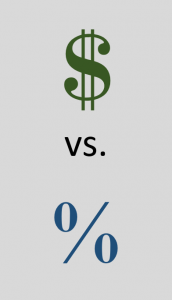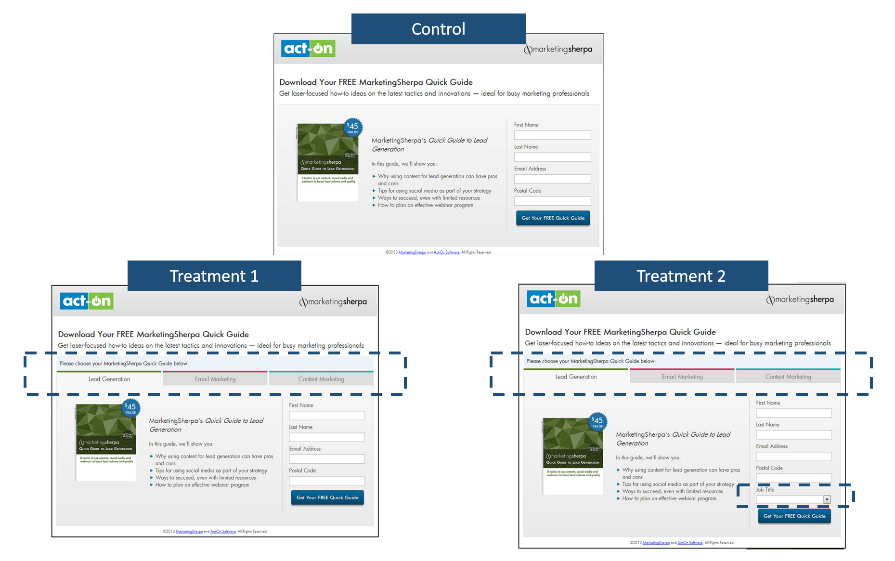Coupon. Free download. Discount code. Gift card. Complimentary ebook.
These are just a few of the countless types of incentives marketers use to influence customers to say “yes” at the final macro-decision – whether that’s making a purchase, filling out a lead gen form or some other form of conversion.
Incentive can be just what some customers need to commit to an action you want them to take. But how can you ensure your incentive offers are having optimal effect on conversion?
Here are three tests you could use to optimize your incentive offers.
 Incentive Test #1. Percentage off vs. Dollar amount off
Incentive Test #1. Percentage off vs. Dollar amount off
This first test idea is definitely a numbers game.
What do customers see more value in: a percentage discount or a defined dollar amount discount? One case study from deep within the library of our sister site MarketingSherpa tested this question.
Evo, an online retailer of outdoor gear and fashion apparel, offered a coupon for certain product packages that had an average price of $333, and a minimum price of $250. With these numbers in mind, the team determined that $50 was the ideal discount point.
In addition to a traditional $50 off coupon, the team elected to test a 15% off coupon as well, which roughly equaled $50 off the average price of $333.
The test produced these results:
- The $50 off coupon produced a 72% higher conversion rate
- The $50 off coupon generated 170% more revenue than the 15% off coupon
It’s important to measure both conversion and overall revenue with this test. Even if one treatment results in more purchases, it may have lower average order amounts. If the average order amount is lower overall, the treatment with fewer orders of higher amounts could be your best choice moving forward.
Incentive Test #2. More prizes with a lower value vs. Fewer prizes with a higher value
Sometimes you’re not looking to determine the best incentive for your audience or customer base. For sweepstakes or contests, you’re looking for the best incentive that only a few will receive, but still appeals to the masses.
For example, let’s look at a test run by a MECLABS workshop alumnus. Troy O’Bryan, Founder, Response Capture, wanted to know which gift card incentive would generate the most conversions. In exchange for providing their email addresses, prospects would have a chance of winning an Amazon gift card with one of two dollar amounts. The catch was that the higher dollar gift card came with fewer chances to win.
Incentive #1 was “a chance to win one of twenty $25 gift cards.”
Incentive #2 was “a chance to win one of ten $50 gift cards.”

In theory, prospects had a higher chance of winning with lower gift card amount because they had more chances to win. However, is the chance to win the higher amount of $50, even at a smaller chance, a greater motivation?
The higher dollar amount won. Incentive #2 generated 31% more conversions. Not a bad result considering there was no financial difference for the company. Each incentive cost the company $500.
This test could be pushed further to see if a single, even larger prize proves to be a better incentive than several smaller prizes.
Incentive Test #3. Predetermined incentive vs. A choice in incentive
What if no single incentive stands out in your test results? Or, what if your audience is very diverse but you lack the data to properly segment? For these and other reasons, offering a choice of incentive options for your customer or prospects could outperform a single incentive.
Our sister research brand MarketingSherpa ran such a test at its Lead Gen Summit 2013.
In partnership with Act-On, an email promoting a free report download was sent to both the Act-On subscriber list and MarketingSherpa’s list.
The Control had four required form fields in exchange for a download of the company’s Lead Generation Quick Guide.
Both treatments allowed visitors to choose a Quick Guide from three different topics. Treatment 2 differs by asking for one more form field to test if the perceived value of incentive choice increases enough for visitors to provide additional information.

The results saw no statistical difference in conversion between the Control and Treatment 1, and Treatment 2 saw a significant decrease from both the control and Treatment 1. Both Treatments saw the defaulted Lead Generation report chosen most often.
This caused the team to wonder if the options presented in tabs were the best choices. Perhaps visitors missed the choice or it could have increased friction on the page.
For our specific audience, the options as they existed didn’t make a difference in conversion. However, every audience is different, so your team could see positive results from such a test.
Before you test – A warning
Before you jump into your first incentive test, I should warn that you might not be ready to test incentives at all. (And I mean this in the nicest way.)
At MarketingExperiments, and our parent organization MECLABS Institute, we believe incentive should be the last thing you test in your marketing collateral.
Incentive is not meant to camouflage bigger issues on your page or in your offer. Take a quick look at our patented Conversion Optimization heuristic:

To get the biggest bang for your incentive buck:
- Make sure your value proposition is clearly and effectively communicated so that you don’t have to rely on pricing strategies.
- Next, you want to reduce friction from your process.
- Then, alleviate anxiety around the elements that cause concern for customers, such as privacy and secure transactions.
You perform the above steps because you want to ensure the core components of your offer, and its webpages and emails, are optimized for your ideal audience. By doing this, your ideal customer will engage with your offer no matter the incentive. You have already provided the value and assurances they need. That’s why they’re your ideal customers.
However, for those who could benefit from your offer, product or service but might have equally strong alternatives, you can now use the incentive to help tip the scale in your direction.
But again, it’s essential that all other pieces are in place and at their best, or else no incentive will matter.
Think of it this way, if you came across an unbelievable sale price for an item you need, but found it on a website that looks unsecure, do you enter your credit card information? Does the incentive of a good price outweigh your anxiety of possibly risking the security of your financial information?
The old adage might come to mind, “If it’s too good to be true, it probably is.”
That’s why it’s imperative to have your foundation with the other elements of the Conversion Optimization heuristic.
With that advice in place, let’s get testing.
You might also like
Incentive: Cause marketing generates 7x more revenue than price discounts for toy manufacturer



